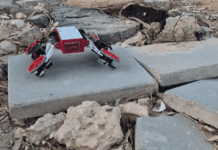This post is also available in:
 עברית (Hebrew)
עברית (Hebrew)
A team at MIT Lincoln Laboratory has developed a compact and inexpensive hydrophone that could transform underwater sensing across defense, industrial, and scientific functions. Built using a commercially available microelectromechanical systems (MEMS) microphone, the new design achieves performance on par with, or even exceeding, much larger and costlier instruments.
Conventional hydrophones, which convert underwater sound waves into electrical signals, are essential for applications ranging from submarine detection to environmental monitoring. However, they are typically large, fragile, and expensive to produce, limiting their use in large-scale or disposable sensor networks. The new device tackles this problem by reimagining the hydrophone around an off-the-shelf MEMS microphone, the same basic technology used in smartphones and hearing aids.
To function underwater, the team encapsulated the microphone in a protective polymer while maintaining a small air cavity around its diaphragm to preserve sensitivity. Through extensive modeling and field testing, they found that the high responsiveness of the MEMS sensor compensates for the signal loss caused by the air gap. The result is a lightweight, durable device that retains excellent signal-to-noise performance, even at depths of 120 meters.
During tests at Seneca Lake in New York, the hydrophone demonstrated sensitivity within just a few decibels of the ocean’s quietest conditions — a benchmark for underwater acoustics. Its small size and low power draw make it ideal for deployment in distributed networks, autonomous underwater vehicles (AUVs), or long-term ocean monitoring systems.
Beyond civilian research, the implications for defense are substantial. A compact, low-cost hydrophone could enable the creation of dense underwater sensor grids for tracking submarines, detecting unmanned underwater vehicles, or monitoring maritime borders. It could also enhance communication and navigation capabilities in naval operations by improving the precision of acoustic mapping and signal collection.
The innovation represents a practical shift in undersea technology — moving from bulky, specialized systems toward scalable and adaptable sensing solutions. With further optimization, this MEMS-based hydrophone could become a foundational tool for the next generation of underwater surveillance and environmental intelligence.
























